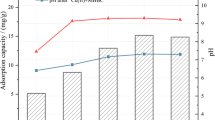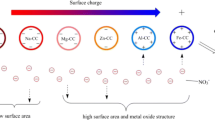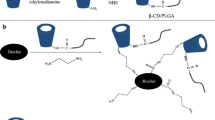Abstract
Modified biochar has attracted wide attention due to its advantageous adsorption performance. However, the influence of modification process of biochar on adsorption capacity was seldom studied. In this study, biochar derived from corn stalks was modified through two kinds of modification processes: pre-pyrolysis (MBCpre) and post-pyrolysis (MBCpost) modification with citric acid, sodium hydroxide, ferric chloride, respectively. The results showed that the biochar modified by ferric chloride (MBC) provided better adsorption capacity for Cr(VI), and the pre-pyrolysis offered more favorable adsorption capacity for biochar than post-pyrolysis. By means of instrumental analysis, it was found that MBCpre owned highly dispersed Fe3O4 particles and larger surface area, which could be the critical role for enhancing the adsorption capacity of MBCpre. Meanwhile, MBCpost appeared more protonated oxygen-rich functional groups(C=O, –OH, etc.) and adsorbed Cr(VI) by electrostatic attraction and complexation. This study will offer a novel idea for the treatment of chromium-containing wastewater by selecting the modification processes of biochar.

Graphical abstract









Similar content being viewed by others

References
Ahmad M, Rajapaksha AU, Lim JE, Zhang M, Bolan N, Mohan D, Vithanage M, Lee SS, Ok YS (2014) Biochar as a sorbent for contaminant management in soil and water: a review. Chemosphere 99:19–33
Altun T, Kar Y (2016) Removal of Cr(VI) from aqueous solution by pyrolytic charcoals. New Carbon Mater 31:501–509
Altun T, Pehlivan E (2012) Removal of Cr(VI) from aqueous solutions by modified walnut shells. Food Chem 132:693–700
Badruddoza AZ, Shawon ZB, Tay WJ, Hidajat K, Uddin MS (2013) Fe3O4/cyclodextrin polymer nanocomposites for selective heavy metals removal from industrial wastewater. Carbohydr Polym 91:322–332
Baig SA, Zhu J, Muhammad N, Sheng T, Xu X (2014) Effect of synthesis methods on magnetic Kans grass biochar for enhanced As(III, V) adsorption from aqueous solutions. Biomass Bioenergy 71:299–310
Behnajady MA (2015) Artificial neural network modeling of Cr(VI) photocatalytic reduction with TiO-P25 nanoparticles using the results obtained from response surface methodology optimization. Desalin Water Treat 56:2906–2916
Behnajady MA, Bimeghdar S (2014) Synthesis of mesoporous NiO nanoparticles and their application in the adsorption of Cr(VI). Chem Eng J 239:105–113
Behnajady MA, Mansoriieh N, Modirshahla N, Shokri M (2012) Influence of operational parameters and kinetics analysis on the photocatalytic reduction of Cr(VI) by immobilized ZnO. Environ Technol 33:265–271
Behnajady MA, Yavari S, Modirshahla N (2014) Investigation on adsorption capacity of TiO2-P25 nanoparticles in the removal of a mono-azo dye from aqueous solution: a comprehensive isotherm analysis. Chem Ind Chem Eng Q 20:97–107
Chen T, Zhou Z, Xu S, Wang H, Lu W (2015a) Adsorption behavior comparison of trivalent and hexavalent chromium on biochar derived from municipal sludge. Bioresour Technol 190:388–394
Chen Z, Xiao X, Chen B, Zhu L (2015b) Quantification of chemical states, dissociation constants and contents of oxygen-containing groups on the surface of biochars produced at different temperatures. Environ Sci Technol 49:309–317
Das DD, Schnitzer MI, Monreal CM, Mayer P (2009) Chemical composition of acid–base fractions separated from biooil derived by fast pyrolysis of chicken manure. Bioresour Technol 100:6524–6532
Demiral H, Demiral I, Tümsek F, Karabacakoğlu B (2008) Adsorption of chromium (VI) from aqueous solution by activated carbon derived from olive bagasse and applicability of different adsorption models. Chem Eng J 144:188–196
Deng H, Yang L, Tao G, Dai J (2009) Preparation and characterization of activated carbon from cotton stalk by microwave assisted chemical activation—application in methylene blue adsorption from aqueous solution. J Hazard Mater 166:1514–1521
Deveci H, Kar Y (2013) Adsorption of hexavalent chromium from aqueous solutions by bio-chars obtained during biomass pyrolysis. J Ind Eng Chem 19:190–196
Ding Z, Hu X, Wan Y, Wang S, Gao B (2016) Removal of lead, copper, cadmium, zinc, and nickel from aqueous solutions by alkali-modified biochar: batch and column tests. J Ind Eng Chem 33:239–245
Dong X, Ma LQ, Li Y (2011) Characteristics and mechanisms of hexavalent chromium removal by biochar from sugar beet tailing. J Hazard Mater 190:909–915
dos Santos Coelho F, Ardisson JD, Moura FC, Lago RM, Murad E, Fabris JD (2008) Potential application of highly reactive Fe (0)/Fe3O4 composites for the reduction of Cr (VI) environmental contaminants. Chemosphere 71:90–96
Ekramul Mahmud HN, Huq AKO, Yahya RB (2016) ChemInform abstract: the removal of heavy metal ions from wastewater/aqueous solution using Polypyrrole-based adsorbents: a review. Cheminform 47:14778–14791
Eskandarloo H, Badiei A, Behnajady M, Ziarani G (2014) Minimization of electrical energy consumption in the photocatalytic reduction of Cr(VI) by using immobilized mg, Ag co-impregnated TiO2 nanoparticles. RSC Adv 4:28587–28596
Feng Z, Chen N, Feng C, Gao Y (2018) Mechanisms of Cr(VI) removal by FeCl3 -modified lotus stem-based biochar (FeCl3 @LS-BC) using mass-balance and functional group expressions. Colloids Surf A Physicochem Eng Asp 551:17–24
Gan C, Liu Y, Tan X, Wang S, Zeng G, Zheng B, Li T, Jiang Z, Liu W (2015) Effect of porous zinc–biochar nanocomposites on Cr(VI) adsorption from aqueous solution. RSC Adv 5:35107–35115
Gao H, Lv S, Dou J, Kong M, Dai D, Si C, Liu G (2015) The efficient adsorption removal of Cr (VI) by using Fe3O4 nanoparticles hybridized with carbonaceous materials. RSC Adv 5:60033–60040
Ghorbani-Khosrowshahi S, Behnajady MA (2016) Chromium(VI) adsorption from aqueous solution by prepared biochar from Onopordom Heteracanthom. Int J Environ Sci Technol 13:1803–1814
Guo H, Bi C, Zeng C, Ma W, Yan L, Li K, Wei K (2017) Camellia oleifera seed shell carbon as an efficient renewable bio-adsorbent for the adsorption removal of hexavalent chromium and methylene blue from aqueous solution. J Mol Liq 249:629–636
Hadjittofi L, Prodromou M, Pashalidis I (2014) Activated biochar derived from cactus fibres–preparation, characterization and application on Cu (II) removal from aqueous solutions. Bioresour Technol 159:460–464
Han Y, Cao X, Ouyang X, Sohi SP, Chen J (2016) Adsorption kinetics of magnetic biochar derived from peanut hull on removal of Cr (VI) from aqueous solution: effects of production conditions and particle size. Chemosphere 145:336–341
Hayati B, Mahmoodi NM (2012) Modification of activated carbon by the alkaline treatment to remove the dyes from wastewater: mechanism, isotherm and kinetic. Desalin Water Treat 47:322–333
He B, Yun Z, Shi J, Jiang G (2013) Research progress of heavy metal pollution in China: sources, analytical methods, status, and toxicity. Chin Sci Bull 58:134–140
Jain M, Garg VK, Kadirvelu K (2010) Adsorption of hexavalent chromium from aqueous medium onto carbonaceous adsorbents prepared from waste biomass. J Environ Manag 91:949–957
Jung C, Heo J, Han J, Her N, Lee S-J, Oh J, Ryu J, Yoon Y (2013) Hexavalent chromium removal by various adsorbents: powdered activated carbon, chitosan, and single/multi-walled carbon nanotubes. Sep Purif Technol 106:63–71
Khambhaty Y, Mody K, Basha S, Jha B (2009) Kinetics, equilibrium and thermodynamic studies on biosorption of hexavalent chromium by dead fungal biomass of marine Aspergillus niger. Chem Eng J 145:489–495
Khan M, Mangrich A, Schultz J, Grasel F, Mattoso N, Mosca D (2015) Green chemistry preparation of superparamagnetic nanoparticles containing Fe3O4 cores in biochar. J Anal Appl Pyrolysis 116:42–48
Li H, Dong X, da Silva EB, de Oliveira LM, Chen Y, Ma LQ (2017) Mechanisms of metal sorption by biochars: biochar characteristics and modifications. Chemosphere 178:466–478
Li M, Liu Q, Guo L, Zhang Y, Lou Z, Wang Y, Qian G (2013) Cu (II) removal from aqueous solution by Spartina alterniflora derived biochar. Bioresour Technol 141:83–88
Li Y, Shao J, Wang X, Deng Y, Yang H, Chen H (2014) Characterization of modified biochars derived from bamboo pyrolysis and their utilization for target component (furfural) adsorption. Energy Fuel 28:5119–5127
Lim S-F, Zheng Y-M, Zou S-W, Chen JP (2008) Characterization of copper adsorption onto an alginate encapsulated magnetic sorbent by a combined FT-IR, XPS, and mathematical modeling study. Environ Sci Technol 42:2551–2556
Liu W-J, Tian K, Jiang H, Yu H-Q (2013) Facile synthesis of highly efficient and recyclable magnetic solid acid from biomass waste. Sci Rep 3:2419
Lu H, Zhang W, Yang Y, Huang X, Wang S, Qiu R (2012) Relative distribution of Pb2+ sorption mechanisms by sludge-derived biochar. Water Res 46:854–862
Lyu H, Tang J, Huang Y, Gai L, Zeng EY, Liber K, Gong Y (2017) Removal of hexavalent chromium from aqueous solutions by a novel biochar supported nanoscale iron sulfide composite. Chem Eng J 322:516–524
Mahmoudi E, Behnajady MA (2018) Synthesis of Fe3O4@NiO core-shell nanocomposite by the precipitation method and investigation of Cr(VI) adsorption efficiency. Colloids Surf A Physicochem Eng Asp 538:287–296
Mohagheghian A, Vahidi-Kolur R, Pourmohseni M, Yang J-K, Shirzad-Siboni M (2017) Application of scallop shell-Fe3O4 nanoparticles for the removal of Cr (VI) from aqueous solutions. Water Sci Technol 75:2369–2380
Mohan D, Sarswat A, Ok YS, Pittman CU Jr (2014) Organic and inorganic contaminants removal from water with biochar, a renewable, low cost and sustainable adsorbent–a critical review. Bioresour Technol 160:191–202
Nethaji S, Sivasamy A, Mandal A (2013) Preparation and characterization of corn cob activated carbon coated with nano-sized magnetite particles for the removal of Cr (VI). Bioresour Technol 134:94–100
Owalude SO, Tella AC (2016) Removal of hexavalent chromium from aqueous solutions by adsorption on modified groundnut hull. Beni-suef Univ J Basic Appl Sci 5:377–388
Panda L, Das B, Rao D, Mishra B (2011) Application of dolochar in the removal of cadmium and hexavalent chromium ions from aqueous solutions. J Hazard Mater 192:822–831
Pradhan D, Sukla LB, Sawyer M, Rahman PK (2017) Recent bioreduction of hexavalent chromium in wastewater treatment: a review. J Ind Eng Chem 55:1–20
Qi W, Zhao Y, Zheng X, Ji M, Zhang Z (2016) Adsorption behavior and mechanism of Cr (VI) using Sakura waste from aqueous solution. Appl Surf Sci 360:470–476
QuiIntana M, Curutchet G, Donati E (2001) Factors affecting chromium (VI) reduction by Thiobacillus ferrooxidans. Biochem Eng J 9:11–15
Ramrakhiani L, Majumder R, Khowala S (2011) Removal of hexavalent chromium by heat inactivated fungal biomass of Termitomyces clypeatus: surface characterization and mechanism of biosorption. Chem Eng J 171:1060–1068
Reddy DHK, Lee S-M (2014) Magnetic biochar composite: facile synthesis, characterization, and application for heavy metal removal. Colloids Surf A Physicochem Eng Asp 454:96–103
Shen B, Li G, Wang F, Wang Y, He C, Zhang M, Singh S (2015) Elemental mercury removal by the modified bio-char from medicinal residues. Chem Eng J 272:28–37
Shen Y, Tang J, Nie Z, Wang Y, Ren Y, Zuo L (2009) Preparation and application of magnetic Fe3O4 nanoparticles for wastewater purification. Sep Purif Technol 68:312–319
Simha P, Yadav A, Pinjari D, Pandit AB (2016) On the behaviour, mechanistic modelling and interaction of biochar and crop fertilizers in aqueous solutions. Resour Effic Technol 2:133–142
Siva T, Kamaraj K, Karpakam V, Sathiyanarayanan S (2013) Soft template synthesis of poly (o-phenylenediamine) nanotubes and its application in self healing coatings. Prog Org Coat 76:581–588
Sizmur T, Fresno T, Akgül G, Frost H, Moreno-Jiménez E (2017) Biochar modification to enhance sorption of inorganics from water. Bioresour Technol 246:34–47
Tan X, Liu Y, Zeng G, Wang X, Hu X, Gu Y, Yang Z (2015) Application of biochar for the removal of pollutants from aqueous solutions. Chemosphere 125:70–85
Tytłak A, Oleszczuk P, Dobrowolski R (2015) Sorption and desorption of Cr (VI) ions from water by biochars in different environmental conditions. Environ Sci Pollut Res 22:5985–5994
Wang XS, Chen LF, Li FY, Chen KL, Wan WY, Tang YJ (2010) Removal of Cr (VI) with wheat-residue derived black carbon: reaction mechanism and adsorption performance. J Hazard Mater 175:816–822
Wilson D, Langell M (2014) XPS analysis of oleylamine/oleic acid capped Fe3O4 nanoparticles as a function of temperature. Appl Surf Sci 303:6–13
Xu R-k, Xiao S-c, Yuan J-h, Zhao A-z (2011) Adsorption of methyl violet from aqueous solutions by the biochars derived from crop residues. Bioresour Technol 102:10293–10298
Yang J, Zhao Y, Ma S, Zhu B, Zhang J, Zheng C (2016) Mercury removal by magnetic biochar derived from simultaneous activation and magnetization of sawdust. Environ Sci Technol 50:12040–12047
Yuan H, Lu T, Huang H, Zhao D, Kobayashi N, Chen Y (2015) Influence of pyrolysis temperature on physical and chemical properties of biochar made from sewage sludge. J Anal Appl Pyrolysis 112:284–289
Yuan J-H, Xu R-K, Zhang H (2011) The forms of alkalis in the biochar produced from crop residues at different temperatures. Bioresour Technol 102:3488–3497
Zhang J, Zheng P (2015) A preliminary investigation of the mechanism of hexavalent chromium removal by corn-bran residue and derived chars. RSC Adv 5:17768–17774
Zhang M-m, Liu Y-g, Li T-t, Xu W-h, Zheng B-h, Tan X-f, Wang H, Guo Y-m, Guo F-y, Wang S-f (2015) Chitosan modification of magnetic biochar produced from Eichhornia crassipes for enhanced sorption of Cr (VI) from aqueous solution. RSC Adv 5:46955–46964
Zhang M, Gao B, Varnoosfaderani S, Hebard A, Yao Y, Inyang M (2013) Preparation and characterization of a novel magnetic biochar for arsenic removal. Bioresour Technol 130:457–462
Zhou L, Liu Y, Liu S, Yin Y, Zeng G, Tan X, Hu X, Hu X, Jiang L, Ding Y (2016) Investigation of the adsorption-reduction mechanisms of hexavalent chromium by ramie biochars of different pyrolytic temperatures. Bioresour Technol 218:351–359
Zhu X, Liu Y, Qian F, Zhou C, Zhang S, Chen J (2014) Preparation of magnetic porous carbon from waste hydrochar by simultaneous activation and magnetization for tetracycline removal. Bioresour Technol 154:209–214
Zhu Y, Li H, Zhang G, Meng F, Li L, Wu S (2018) Removal of hexavalent chromium from aqueous solution by different surface-modified biochars: acid washing, nanoscale zero-valent iron and ferric iron loading. Bioresour Technol 241:142–150
Ziaeifar N, Khosravi M, Behnajady MA, Sohrabi MR, Modirshahla N (2015) Optimizing adsorption of Cr(VI) from aqueous solutions by NiO nanoparticles using Taguchi and response surface methods. Water Sci Technol 72:721–729
Funding
This work was supported in part by the Technology innovation and application demonstration of Chongqing science and technology planning project (Project No. cstc2018jscx-msybX0308).
Author information
Authors and Affiliations
Corresponding author
Ethics declarations
Conflict of interest
The authors declare that they have no competing interests.
Additional information
Responsible editor: Hailong Wang
Electronic supplementary material
ESM 1
(DOCX 20 kb)
Rights and permissions
About this article
Cite this article
An, Q., Li, XQ., Nan, HY. et al. The potential adsorption mechanism of the biochars with different modification processes to Cr(VI). Environ Sci Pollut Res 25, 31346–31357 (2018). https://doi.org/10.1007/s11356-018-3107-7
Received:
Accepted:
Published:
Issue Date:
DOI: https://doi.org/10.1007/s11356-018-3107-7



